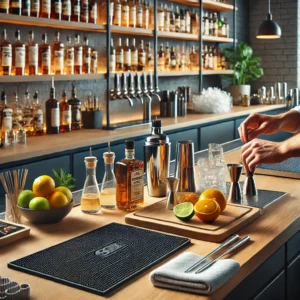Newbie Bartender Guide
Newbie bartender guide: Welcome to your first shift behind the stick. The excitement pulses in your veins. You stand in front of rows of gleaming bottles. Meanwhile, your heart races with anticipation. In this guide, you will learn clear steps. You’ll gain confidence. You’ll connect with guests. And you’ll craft cocktails that delight.
Why You Need a Newbie Bartender Guide
Starting out can feel overwhelming. There are so many tools, techniques, and terms. Moreover, you want to avoid feeling lost at the bar. Therefore, this newbie bartender guide breaks things down. First, we cover the basics. Next, we explore key skills. Then, we add personality with storytelling and flair.
Setting Up Your Station

A clean station means a clear mind. Begin by polishing your glassware. Line up shakers, strainers, and jiggers. Arrange bottles by type: spirits, liqueurs, mixers. Meanwhile, stock fresh garnishes in cups. Ice bins should be full and chilling. As you work, remember: organization is your friend. It helps you move swiftly when orders pile up.
Essential Tools and Glassware

Every bartender needs a toolkit. Your newbie bartender guide insists on the basics:
– Cocktail shaker
– Jigger for exact measures
– Bar spoon for stirring
– Strainer to catch shards
– Muddler for herbs and fruit
– Clean glassware for each serve
– Invest in sturdy tools now. They will last for years.
Mastering Pouring and Measuring

Precision shapes flavor. First, learn to free-pour by feel. Practice with water. Count seconds: two counts for one ounce. Then, use a jigger to confirm ratios. Next, train your muscle memory. Soon, you will pour with confidence under pressure. Remember, consistent measures build balanced drinks.
Shaking, Stirring, and Muddling

Techniques define texture. Shaking chills and aerates. Stirring blends delicate ingredients. Muddling releases oils and juices. Follow these tips:
– Hold shaker at two contact points
– Shake in time to a steady beat
– Use slow, smooth strokes for stirring
– Press gently when muddling herbs
– These steps ensure each drink tastes its best.
Building Your Cocktail Vocabulary

Learn key terms: neat, on the rocks, double, twist. Moreover, understand flavor profiles: sweet, sour, bitter, umami. When you know the language, you can craft and customize. Guests notice when you speak like an expert. This newbie bartender guide helps you sound confident from day one.
Connecting with Guests

Bartending is part performance. Eye contact and a smile go far. Ask about preferences. Tell a brief story about the drink. For example, share how a classic Old Fashioned warmed your spirits on a winter night. Personal touches create emotional connections. They turn strangers into friends.
Common Cocktails Every Beginner Should Master

– Start with the classics:
– Old Fashioned
– Martini
– Mojito
– Whiskey Sour
– Negroni
Practice these recipes until you can make them blindfolded. Learning classics builds a strong foundation for creativity.
Troubleshooting and Expert Tips
Spills happen. Remain calm and clean swiftly. Over-shaken cocktails? Let ice settle before pouring. Too tart? Add a splash of simple syrup. These fixes come from years behind the bar. Keep them in mind as a rookie. They will save you more than once.
Growing Beyond the Bar Mat

Read cocktail history books. Watch masterclasses online. And most importantly, taste widely. Attend local tastings. Ask mentors for feedback. Every shift is a lesson in the art of hospitality.
Your Journey Begins Now

This newbie bartender guide arms you with skills and confidence. Remember to stay curious. Embrace mistakes as learning moments. Above all, keep the fun alive. Bartending is about people. It is about stories. So lift that shaker, and let your passion shine through. Cheers to your first pour and every pour after.